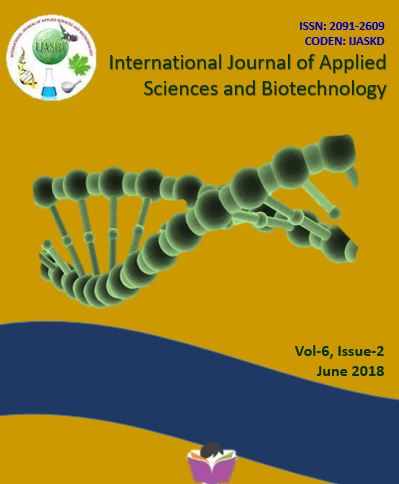Soil Fertility Mapping of Different VDCs of Sunsari District, Nepal Using GIS
DOI:
https://doi.org/10.3126/ijasbt.v6i2.20424Keywords:
Geographic Information System, Global Positioning System (GPS), Kriging, Soil fertility mapping, Soil NPKAbstract
Soil fertility degradation has become a major problem for agricultural management in Nepal. A detailed soil fertility status of different VDCs of Sunsari district was investigated during 2015 and soil related crop production constraints were identified for proper utilization of agricultural land. Total 131 numbers of geo-referenced (GPS based) composite surface soil samples (0-15 cm) were collected from eleven Village Development Committees of Sunsari District. The sample points were recorded with a differential global position system and mapped using Geographic Information System (GIS). Soils were analyzed for mechanical composition, pH, organic matter, total nitrogen, available phosphorus, potassium and micronutrients like Boron, Zinc, Copper and Iron. About 38.9% soils were found to be silty clay loam, 20.6% were silty clay, 19.1% were clay loam and 21.4% were of other textural classes. Most of the soils were acidic and only few were neutral and slightly alkaline in nature. Soil Organic matter varies from 3.57% to 0.28% with a mean value of 1.53 %. The mean total nitrogen, available phosphorus, potassium was found to be 0.08%, 44.37 kg/ha and 128.04 kg/ha respectively. The mean hot water extractable Boron, DTPA extractable Copper, Zinc and Iron was found to be 0.14, 0.06, 0.15 and 10.71 mg/kg respectively. Thematic maps were prepared for each soil parameters using ArcGis10.1 software and ordinary Kriging interpolation was used in order to predict values for not sampled locations. The fertility maps provide the readymade source of information about soil fertility status and serve as the decision making tool for successful raising and development of crops. It can be concluded from the above study that GPS and GIS based soil fertility maps helps farmers, scientists, planners and students in providing soil test based fertilizer recommendation for intensive and sustainable site specific crop production.
Int. J. Appl. Sci. Biotechnol. Vol 6(2): 142-151
Downloads
1155
1055




